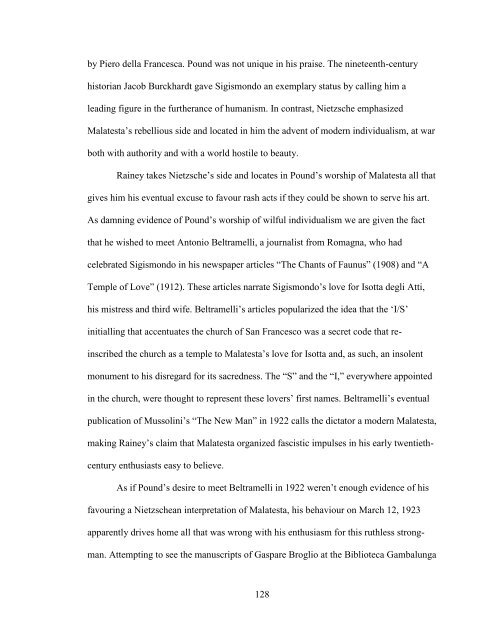TABOO: THE ACTUAL MODERNIST AESTHETIC, MADE REAL A ...
TABOO: THE ACTUAL MODERNIST AESTHETIC, MADE REAL A ...
TABOO: THE ACTUAL MODERNIST AESTHETIC, MADE REAL A ...
Create successful ePaper yourself
Turn your PDF publications into a flip-book with our unique Google optimized e-Paper software.
y Piero della Francesca. Pound was not unique in his praise. The nineteenth-century<br />
historian Jacob Burckhardt gave Sigismondo an exemplary status by calling him a<br />
leading figure in the furtherance of humanism. In contrast, Nietzsche emphasized<br />
Malatesta‘s rebellious side and located in him the advent of modern individualism, at war<br />
both with authority and with a world hostile to beauty.<br />
Rainey takes Nietzsche‘s side and locates in Pound‘s worship of Malatesta all that<br />
gives him his eventual excuse to favour rash acts if they could be shown to serve his art.<br />
As damning evidence of Pound‘s worship of wilful individualism we are given the fact<br />
that he wished to meet Antonio Beltramelli, a journalist from Romagna, who had<br />
celebrated Sigismondo in his newspaper articles ―The Chants of Faunus‖ (1908) and ―A<br />
Temple of Love‖ (1912). These articles narrate Sigismondo‘s love for Isotta degli Atti,<br />
his mistress and third wife. Beltramelli‘s articles popularized the idea that the ‗I/S‘<br />
initialling that accentuates the church of San Francesco was a secret code that re-<br />
inscribed the church as a temple to Malatesta‘s love for Isotta and, as such, an insolent<br />
monument to his disregard for its sacredness. The ―S‖ and the ―I,‖ everywhere appointed<br />
in the church, were thought to represent these lovers‘ first names. Beltramelli‘s eventual<br />
publication of Mussolini‘s ―The New Man‖ in 1922 calls the dictator a modern Malatesta,<br />
making Rainey‘s claim that Malatesta organized fascistic impulses in his early twentieth-<br />
century enthusiasts easy to believe.<br />
As if Pound‘s desire to meet Beltramelli in 1922 weren‘t enough evidence of his<br />
favouring a Nietzschean interpretation of Malatesta, his behaviour on March 12, 1923<br />
apparently drives home all that was wrong with his enthusiasm for this ruthless strong-<br />
man. Attempting to see the manuscripts of Gaspare Broglio at the Biblioteca Gambalunga<br />
128
















